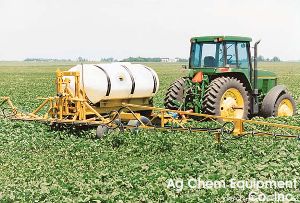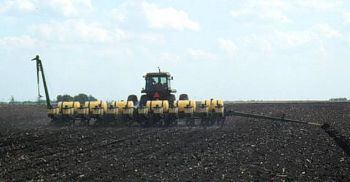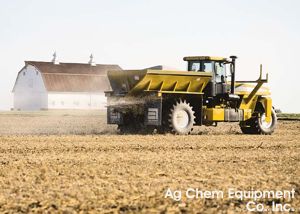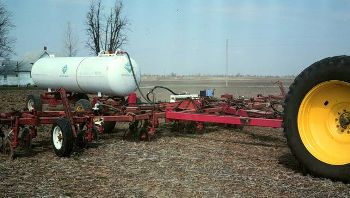|
 |
 |
Nutrient
Management
| |

Source: USDA - National Resources Conservation Service
|
Plant nutrients, which come primarily from chemical fertilizers, manure,
and in some cases sewage sludge, are essential for crop production. When
applied in proper quantities and at appropriate times, nutrients (especially
nitrogen, phosphorus, and potassium) help achieve optimum crop yields.
However, improper application of nutrients can cause water quality problems
both locally and downstream. Nutrient management is the practice
of using nutrients wisely for optimum economic benefit, while minimizing
impact on the environment.
Operations and Timing
Farmers sometimes apply fertilizer soon after the previous year's harvest,
since equipment and labor are usually available then. Fertilizer can also
be applied in the spring, near the time it is needed by the plant, usually
at planting, or as side-dress
after the crop has started to grow. In general, the greatest efficiency
results when fertilizer is applied at planting time or during the early
part of growing season.
Proper timing is most important with nitrogen fertilizer. In some locations,
a large part of the nitrogen may be lost if it is applied too long before
the crop is planted, particularly if applied the previous fall before
soil temperature drops to below 50° F. Phosphorus application is also
most efficient when made at or near planting time, especially with soils
low in phosphorus. Time of application is less critical with potassium
than with nitrogen or phosphorus.

Source: USDA - National Resources Conservation Service
|
Knowing how much fertilizer to apply can be difficult. Soil
tests are used to determine soil deficiencies for nutrients such as
phosphorus and potassium. It is more difficult to determine nitrogen needs
in advance, however, and most farmers simply use standard nitrogen recommendations
based on crop yield goals. Recommendations are provided by Cooperative Extension
services in most states. Other farmers get recommendations from fertilizer
dealers and crop consultants.
Common nitrogen fertilizers are anhydrous
ammonia (82% nitrogen), urea (45%
nitrogen), urea and ammonium nitrate solutions (28% nitrogen), and ammonium
nitrate (33.5% nitrogen). Manure can be an excellent source of Nitrogen
(N), Phosphorous (P), and Potassium (K) plant nutrients. Every load of
manure is different, however, so manure testing is necessary to accurately
estimate nutrient contents.
Back to Top
Equipment Used

|
| Farm tractor and tillage implement |
| (Source: Daniel R. Ess,
Purdue University) |
Tractors - are traction machines that provide mechanical,
hydraulic, and/or electrical power to implements to perform a wide range
of crop production and handling operations. Tractors are most often used
to perform drawbar work and PTO
(power take-off) work. Tractors can be equipped with rubber tires, rubber
belts, or steel tracks. A modern farm tractor is almost always equipped
with a diesel engine and tractor size is measured by the amount of power
that the tractor can produce at the PTO. Tractor sizes range for those with
less than 40 PTO horsepower to ones that produce more than 400 horsepower.
The cost of a large tractor can exceed $200,000.
| 
|
A tractor-sprayer-field cultivator
combo
that performs tillage and crop chemical
application operations simultaneously. |
| (Source: ag-chem, a division
of AGCO Corporation.) |
Sprayers - are implements or vehicles used to apply liquid
crop chemicals, most often herbicides, and increasingly, fertilizers. Sprayers
typically include a tank, pump, plumbing, valves, a boom, and nozzles. Sprayers
can be mounted on a tractor or other implement, pulled by a tractor, self-propelled,
or mounted on airplanes or helicopters. Large self-propelled sprayers that
incorporate technologies to vary application rates within a field can cost
more than $250,000.
| A self-propelled sprayer broadcasting crop
chemicals in the field. |

(Source: ag-chem, a division of AGCO
Corporation.) |
| A pull-type sprayer and tractor. |

(Source: ag-chem, a division of AGCO Corporation.)
|
| 
|
A twelve-row planter working
in a
conventionally-tilled field. |
| (Source: Daniel R. Ess,
Purdue University) |
Planters - are implements used to plant row crops (typically
in row spacings ranging from 10 to 40 inches). Planters open a seed trench,
meter seeds one-at-a-time, drop seeds into the seed trench, and gently cover
the seed. Some planters can cut through residues and till a small strip
of soil in each row at the time of planting. Planters can also be equipped
to apply liquid fertilizer, pesticides, and herbicides during planting.
Planters come in sizes as large as sixty feet wide – that is twenty-four
rows with a typical 30-inch row spacing, or thirty-six rows with a narrower
20-inch row spacing. Such large planters can cost in excess of $100,000.
| Spreaders - are implements or vehicles
used to apply dry crop chemicals, most often fertilizers. Spreaders
typically include a bed, conveyor, and either a set of spinning disks
to distribute material over a wide area or a pneumatic system to push
material through openings in a boom for distribution on the ground.
Spreaders can be mounted on a tractor, pulled by a tractor, self-propelled,
or mounted on airplanes. Large self-propelled spreaders that incorporate
technologies to vary application rates of multiple dry chemicals within
a field can cost more than $250,000. |
| A self-propelled spreader that
uses spinning disks to distribute dry crop chemicals. |

(Source: ag-chem, a division of AGCO Corporation.)
|
| A self-propelled spreader that
uses a pneumatic system to evenly distribute dry crop chemicals. |

(Source: ag-chem, a division of AGCO Corporation.) |

|
A tractor-drawn toolbar being
used to inject
anhydrous ammonia into the soil. The wagon
mounted tank attached to the toolbar
supplies ammonia. |
| (Source: Daniel R. Ess,
Purdue University) |
Toolbars - are implements that can use a range of soil-engaging
tools typically mounted to a long steel bar of rectangular cross-section.
A toolbar equipped with a set of uniformly spaced steel discs can be used
to create trenches in the soil into which liquid fertilizers can be applied
or gaseous fertilizers (such as anhydrous ammonia) can be injected. Toolbar
fertilizer applicators lend themselves to sidedress application in standing
crops.
Back to Top
Potential Environmental Concerns
Water quality problems can occur when nutrients are added to the soil
at a time when they could be removed in surface runoff from rainfall or
snow melt at rates exceeding that removed by the crop, or if applied at
times that they cannot be utilized by the crop.
When nitrogen or phosphorus are present in lakes or rivers at a high
concentration, a condition called "eutrophication"
or biological enrichment can occur. High nitrogen from the Mississippi
River has been blamed for a hypoxic or "dead" zone in the Gulf
of Mexico, where excess algae grow in response to the enriched nutrient
solution and few fish can be found. When the algae die, their decomposition
consumes enough dissolved oxygen to suffocate fish and other animal life.
Sources of nitrogen contributing to the problem include agricultural runoff,
sewage treatment plants, atmospheric nitrogen, and other sources.
Excessive nitrate in ground water can present a direct health hazard
to very young infants. Ingestion of nitrate (NO3) can bind
with hemoglobin in the infant's bloodstream and cause a condition called
methemoglobinemia or "blue baby" syndrome. Nitrate does not
bind to soil particles and is quite soluble, making it susceptible to
leaching into groundwater if not used by the crop.
Back to Top
Best Management Practices
- Use regular soil
tests to determine nutrient needs, and apply only
the amount of nutrients needed by the crop to be grown. Site-specific
nutrient application varies the amount of nutrients within fields
based on a series of soil tests and global positioning equipment.
- Use manure tests to determine nutrient content,
and take credit for the nutrient content of manure.
- Use conservation tillage and other erosion-control
practices to minimize loss of phosphorus that is attached
to the soil. (See Best Management Practices
for Soil Erosion).
- Improve timing of fertilizer application,
applying nutrients just before they are needed by the crop. Most
of the nitrogen is needed by corn after the plant is three to
four weeks old. The most efficient method of applying N fertilizer
is as sidedress after planting.
- Look for a low soil test
to decide which field to apply manure on and base manure application
rate on the manure test for N.
|

Source: USDA - National Resources Conservation Service
|
Back to Top
 Back
to Crop Production Menu Back
to Crop Production Menu
|

